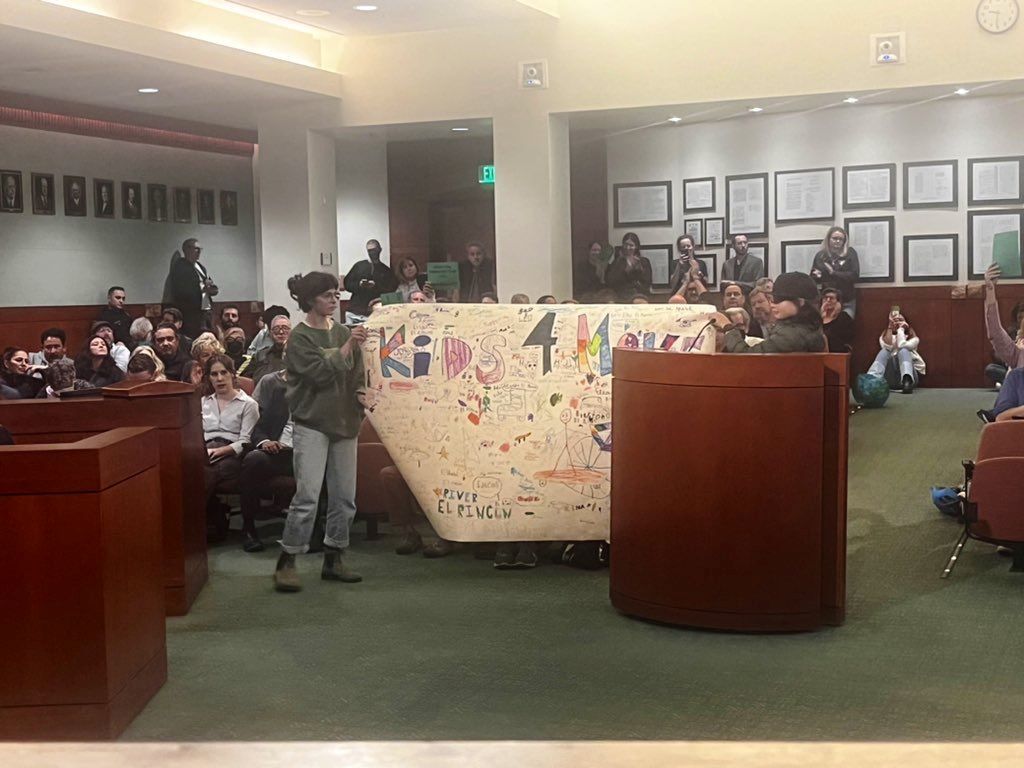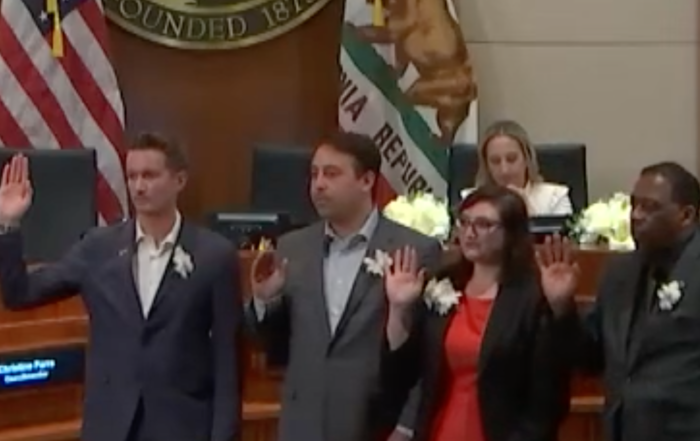In a 3-2 vote, the city council of Culver City voted to make redesigns to the MOVE Culver City project in Downtown Culver City. The project, which removed a lane of traffic down Culver Blvd. in favor of a bus lane and protected bike lane, is set to be adjusted to create a single shared bus and bike lane while adding a second lane of vehicular traffic from Culver Blvd. and Duquesne Ave. to Washington Blvd. and Helms Ave.
The motion — which Vice Mayor Yasmine Imani-McMorrin and councilmember Freddy Puza opposed — also frames this move as a second pilot program that will last no longer than two years.
This was the option that the city’s Downtown Business Association and many of the businesses in the vicinity were in favor of in hopes that adding a second lane of traffic will make accessibility to their businesses easier.
Kathleen Lundeen and Francesco Sinatra — owners of Lundeen’s and Pasta Sisters respectively — were among the business owners in the corridor to speak in favor of the newly planned configuration. They said that they felt the project made the Downtown area less accessible for drivers based on interactions with their customers, making many less inclined to make the trip to patronize their businesses.
“I still get daily complaints from the customers that actually make it to the store about how difficult it was to get there in Downtown,” Lundeen said.
But many of the approximately 200 speakers, several of them local students, spoke in favor of making the current configuration permanent while looking to continue to expand on the formula throughout the city. Among those speakers were former mayors Alex Fisch and Meghan Sahli-Wells, Leah Pressman with the Culver City Democratic Club, Advisory Committee on Housing and Homelessness Vice Chair Bubba Fish, and member Khin Khin Gyi.
These speakers argued for the council to move to make permanent installations for the project as it currently stands, citing their own enjoyment of the lanes and the safety they bring. Parents and children both spoke about how they use the lanes and worried about what changing them might mean for their own safety.
“I hope you hear that love for the project tonight,” Fish said in his comments.
Additionally, several county and state officials also sent letters to the council prior to the meeting supporting the project and imploring council members not to roll back the project for vehicular traffic. This list includes but is not limited to, Los Angeles County Supervisors Holly J. Mitchell and Lindsey P. Horvath, California Assemblymember Issac Bryan, and L.A. 5th District Councilmember Katy Young Yaroslavsky.
Following over three hours of public comment, council members began to share their own thoughts prior to their vote starting around 12:45 a.m.
The majority opinion from Mayor Albert Vera and Councilmembers Goran Eriksson and Dan O’Brien hinged on several factors, most of them centering around the analysis of the project’s efficacy in achieving its goals.
Members of city staff presented pieces of data from a larger post-pilot report prior to public comment, which indicated that the project provided benefits like increased bus ridership and increased sales tax revenue in the corridor.
The majority argued that much of the data used as a benchmark came from during the COVID-19 pandemic, which made the validity of these metrics unclear. Eriksson and Vera also noted the results of a survey done as part of the analysis of the project, which showed that many residents were actually against the project.
Results from this survey taken from the post-pilot report showed just 13 percent of respondents wanted MOVE Culver City to continue to exist in its current form, while 47 percent wanted it to continue with “changes to address concerns raised by residents and local businesses along the corridor.”
The council members acknowledged the many speakers who spoke in the council chambers Monday night, but emphasized the importance of trying to work with both sides and believe that the less permanent option was the best way to do that. In his own comments, O’Brien emphasized his belief in this compromise.
On the other end, McMorrin and Puza argued in the same vein as many of the supporters of the more permanent option. Having these lanes made more permanent will further support the safety of people trying to get around in Culver City while also helping cut down on the city’s carbon footprint.
They argued that the MOVE project is about giving people options to use different modes of transportation and reiterated a point Eriksson made in his own comments: an effective and robust public transportation system is the only way to solve traffic problems in the city.
“Bike lanes alone won’t solve our issues, and public transportation will move the most people through the corridors and the city,” Puza said.
Puza acknowledged the project wasn’t perfect as is, and noted he would support the permanent option with adjustments like improving the timing of lights, expanding on signage, and adding pedestrian scrambles — also known as X Crossings. But he noted that the data shows that the project is meeting sustainability and equity goals, and called the decision one of “political courage.”
“We can choose to move forward with a comprehensive and holistic plan,” Puza said, “or water it down, setting up for failure, and kicking the can down the street once again.”
McMorrin said that car accidents are the number one cause of death among people under 14 in the county, and argued that the MOVE Culver City project is a compromise itself in a city whose infrastructure is centered almost entirely on cars.
“MOVE allows us the opportunity to create the conditions for alternative forms of travel, and this is the only one,” McMorrin said.
She also noted the disproportionate impact that a rollback in transit would cause to lower-income communities, arguing a move to rollback MOVE Culver City would “[exclude] community members who are most vulnerable.” Puza referenced this in his comments, noting the average income of riders on buses within the corridor is around $35,000.
Following these comments, Mayor Vera made a motion to move forward with the shared bus and bike lane option for a pilot program not lasting more than two years. The motion passed, with Vera, O’Brien, and Eriksson in favor and McMorrin and Puza against.
O’Brien also made a motion to extend the project from Washington Blvd. and La Cienega Ave. down to Washington Blvd. and Fairfax Ave., where a Los Angeles Transit Center is currently located. This motion also passed with the same 3-2 split.
Photo Caption: Among the students who spoke at the meeting was Culver City Middle School student Dionysios Kalofonos, who brought a banner supporting the MOVE Culver City signed by kids throughout the Culver City School District. “I am in support of MOVE Culver City because it will ensure mine and many others’ safety,” he said.
Photo Permission and Credit to Vice Mayor McMorrin
Stay informed. Sign up for The Westside Voice Newsletter
By clicking submit, you agree to share your email address with Westside Voice. We do not sell or share your information with anyone.








